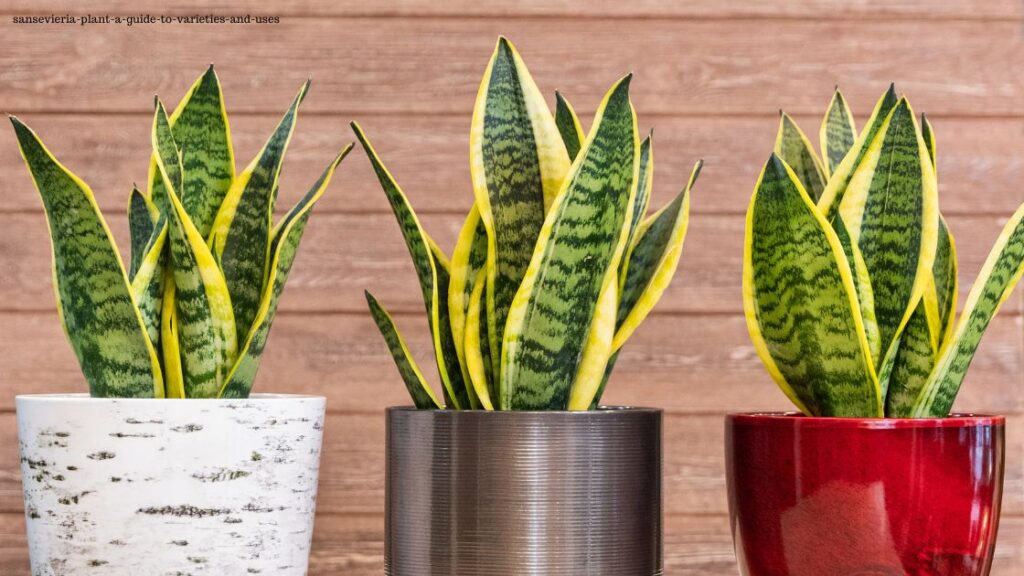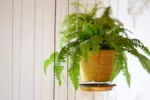Sansevieria, also known as mother-in-law’s tongue or snake plant, is a low-maintenance houseplant with stiff, erect leaves in various hues and designs.
Types of Sansevieria Plants
Here are some of the most popular varieties:
- Sansevieria Trifasciata ‘Laurentii’
- Sansevieria Trifasciata ‘Hahnii’
- Sansevieria Trifasciata ‘Moonshine’
- Sansevieria Trifasciata ‘Black Gold’
- Sansevieria Cylindrica
- Sansevieria Masoniana
- Sansevieria Ehrenbergii
Benefits of the Sansevieria Plant
Air purification: Sansevieria is well known for its capacity to eliminate airborne pollutants like formaldehyde, benzene, xylene, and trichloroethylene. Common home materials including paint, carpeting, and cleaning supplies contain these poisons. Sansevieria plants have the potential to enhance indoor air quality and lessen respiratory issues by eliminating airborne pollutants.
Low maintenance: Sansevieria plants can withstand a broad range of environments and are quite forgiving. They can survive under low light levels and need very little water.
advantages to human health: Research indicates that indoor plants such as Sansevieria may offer health advantages beyond air filtration. Sansevieria plants have the ability to elevate mood and lessen anxiety and tension.
Disadvantages of the Sansevieria Plant
While Sansevieria plants have many advantages, there are also a few considerations to keep in mind:
Toxicity: Sansevieria plants are regarded as slightly harmful if consumed, particularly by dogs and cats. Symptoms like nausea, vomiting, and diarrhea may occur after consumption. This is particularly crucial to think about if you have dogs or inquisitive kids who could be tempted to chew on the leaves.
Slow growth: Sansevieria plants are known for their slow growth rate. This can be a plus for those who don’t want a fast-growing plant that will quickly outgrow its pot. Sansevieria may not be the best choice if you’re seeking rapid growth or significant foliage expansion.
Limited propagation options: Propagating Sansevieria plants can be trickier than some other houseplants. While the division of the rhizomes (underground stems) is possible, it requires careful handling to avoid damaging the plant.
Sansevieria Plant Care

Sure, here’s how to care for your Sansevieria, also known as a Snake Plant:
Light: Sansevieria thrives in indirect sunlight but can tolerate low light conditions. When it’s really hot outside, stay out of direct sunlight. It can burn the leaves.
Watering: Let the soil dry completely in between applications of water. As root rot might result from overwatering, it’s best to err on the side of underwatering. The most common mistake people make with snake plants is overwatering. Plant death may result from root rot brought on by overwatering.
Soil: Sansevieria prefers well-draining soil. A mix of potting soil, sand, and perlite works well. In order to avoid waterlogging, make sure the pot includes drainage holes.
Fertilizing: Feed your Sansevieria with a balanced liquid fertilizer diluted to half-strength during the growing season (spring and summer). Snake plants are not heavy feeders, so use fertilizer sparingly.
Temperature: Snake plants prefer warm temperatures between 55°F and 85°F. They can tolerate cooler temperatures, but they may not grow as quickly.
Propagation of Sansevieria Plant
Of course! Here is a more straightforward step-by-step manual for growing Sansevieria plants:
Method for Making Leaf Cuttings: Pick a robust leaf from the parent plant.
- Cut the leaf into portions that are two to three inches long using clean scissors. Ensure that each segment has a small amount of the horizontal stem, or rhizome, and a part of the leaf.
- To avoid rotting, let the cuttings dry for a day or two so that callus forms.
- Place the cuttings upright in a container with soil that drains well. With the callused end down and the leaf section above the earth, bury them approximately an inch deep in the ground.
- Lightly moisten the soil and position the pot in an area with bright, indirect light.
- Just a light sprinkling will do the soil justice; avoid overwatering it. In a few weeks, the cuttings ought to send roots outward and produce new growth.
Repotting of Sansevieria Plant
The method of repotting a Sansevieria plant is simple. This is a brief manual to assist you in navigating it:
Select the Appropriate Time: Repotting your Sansevieria is most effective in the spring or early summer. During the growth season, this enables the plant to recuperate and establish itself in its new container.
Choose an Appropriate Pot: Select a fresh pot that is marginally bigger than the existing one. Make sure the bottom has drainage holes to prevent waterlogging.
Get the Plant Ready: Give the Sansevieria some water two days before you report them. This facilitates the process of removing the plant from its present container by loosening the soil.
Plant Removal: To remove the root ball, gently tip the pot sideways, support the plant’s base, and tap the pot’s rim. After the plant is free, carefully remove it from the pot.
Examine the Foundations: Look for any indications of overcrowding or decay in the roots. Using clean scissors or pruning shears, remove any dead or rotten roots.
Position the plant in the new pot: Place your Sansevieria in the center of the new pot, ensuring the base sits at about the same depth it did in the old pot.
Sansevieria Plant Disease
few common diseases that can affect Sansevieria plants:
Root Rot: Happens from overwatering. Roots get soggy and rot. Solution: water less often, and ensure good drainage.
Leaf Spot: Caused by fungi or bacteria, shows as dark spots on leaves. Improve air circulation and remove any afflicted leaves.
Fungal Diseases: Like powdery mildew or stem rot. Avoid overwatering, and ensure good ventilation.
Pests: Not a disease, but pests like spider mites or mealybugs can harm the plant. To get rid of them, apply neem oil or insecticidal soap.
Sansevieria Plant Vastu
Here are some guidelines for placing Sansevieria plants according to Vastu principles:
- Direction: Place Sansevieria in the north or east for positive energy flow.
- Location: Living rooms are ideal; avoid bedrooms.
- Care: Keep the plant healthy for positive vibes.
- Number: Odd numbers (like 3 or 5) are auspicious.
- Avoidance: Don’t place them in corners or near the main entrance.
Sansevieria Plant for Pets
Toxicity: If consumed by pets, such as dogs or cats, Sansevieria plants are poisonous.
Symptoms: When pets eat Sansevieria, they may experience diarrhea, vomiting, or other digestive problems.
Precautions: Choose pet-safe substitutes or keep Sansevieria plants out of the reach of animals.
Pet-safe Plants: If you have pets at home, think about non-toxic plants like Boston ferns or spider plants.
Vet Care: Get veterinarian attention right away if you think your pet may have eaten Sansevieria or any other hazardous plant.
How to Buy Sansevieria Plant
Here are some simple tips for buying a low-cost Sansevieria plant:
Online Stores: Look for deals on websites like Amazon, eBay, or Etsy.
Local Nurseries: Visit nearby plant nurseries or garden centers for affordable options.
Community Groups: Check community groups or online marketplaces like Facebook Marketplace for people selling plants at lower costs.
Sansevieria Plant Names in Other Languages
Here are some common names:
- English: Sansevieria, Snake Plant, Mother-in-law’s Tongue
- Spanish: Lengua de suegra, Espada de San Jorge
- French: Langue de belle-mère, Sansevière
- German: Schwiegermutterzunge, Bogenhanf
- Italian: Lingua di suocera, Sanseveria
- Portuguese: Espada-de-são-jorge
- Dutch: Vrouwentong, Sanseveria
- Russian: Сансевиерия (Sansevieriya)
- Chinese (Mandarin): 虎尾兰 (Hǔwěilán)
- Japanese: サンセベリア (Sanseberia)
- Telugu: సంసేవిరియా (Sansevieria)
- Hindi: सैन्सेवियरिया (Sansevieria)
- Kannada: ಸ್ಯಾನ್ಸೇವಿರಿಯಾ (Sansevieria)
- Tamil: சான்சேவியேரியா (Sansevieria)
Conclusion
The Sansevieria plant, also known as a Snake Plant, is a fantastic choice for any plant owner. It’s tough and low-maintenance, perfect for beginners or forgetful plant parents.
FAQs of Sansevieria Plant
- Which variety of snake plant is best?
Ans: The “best” snake plant depends on what you like! There are many kinds with different colors, sizes, and shapes. - How often should I water my Snake Plant?
Ans: Water only when the soil is completely dry. Overwatering is the most common mistake. - What kind of soil does a Sansevieria need?
Ans: Well-draining cactus or succulent mix is ideal. - When should I report my Snake Plant?
Ans: Repot when the plant is rootbound or when growth slows. Spring/summer is ideal. - Can I propagate Snake Plants?
Ans: Yes! You can propagate through leaf cuttings or the division of pups. - Are Snake Plants Toxic?
Yes, to pets and humans if ingested. - What are the advantages of snake plants?
Easy care, cleans the air, looks sharp!



I’ve recently started a site, the info you offer on this site has helped me tremendously. Thank you for all of your time & work.